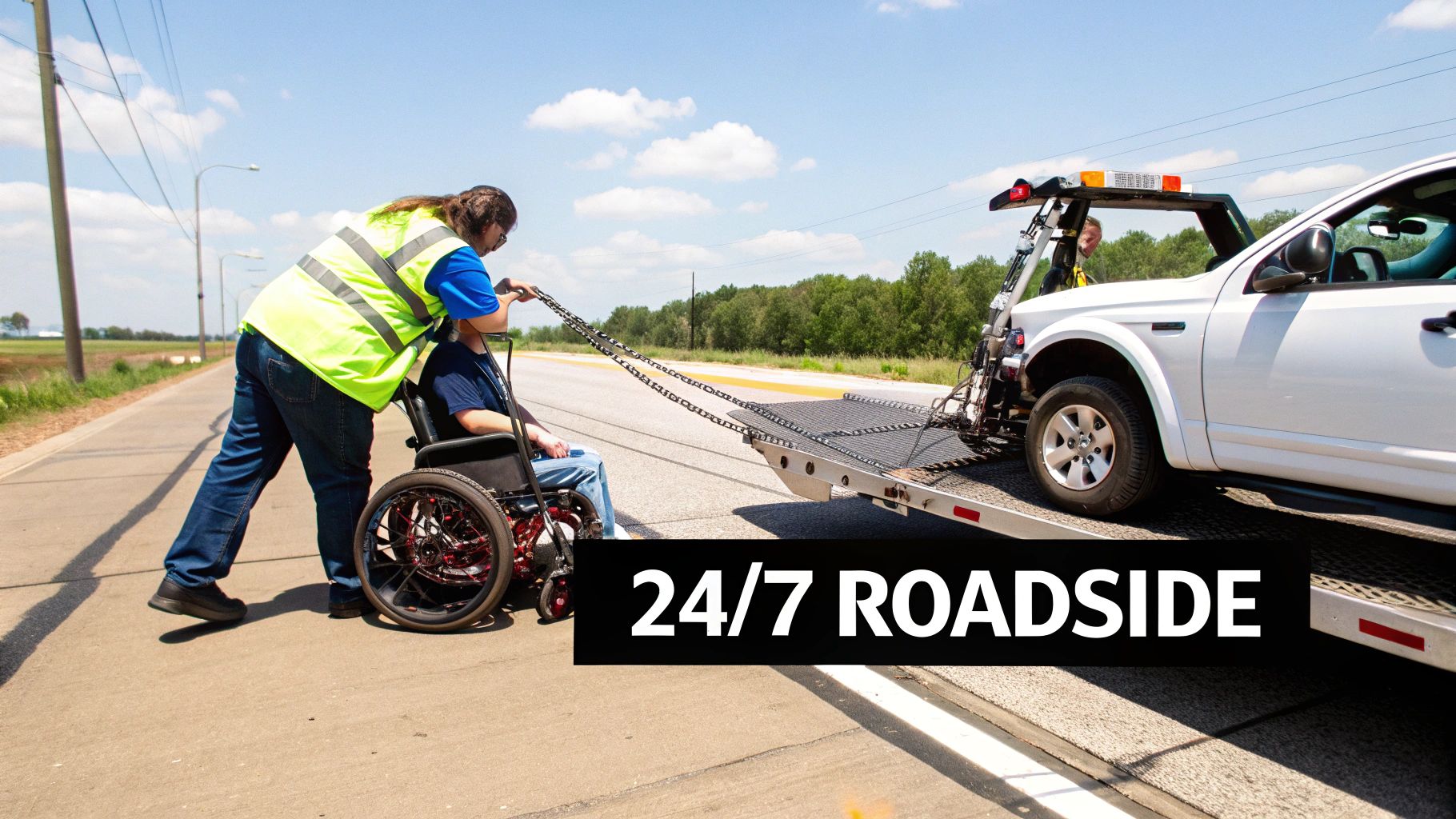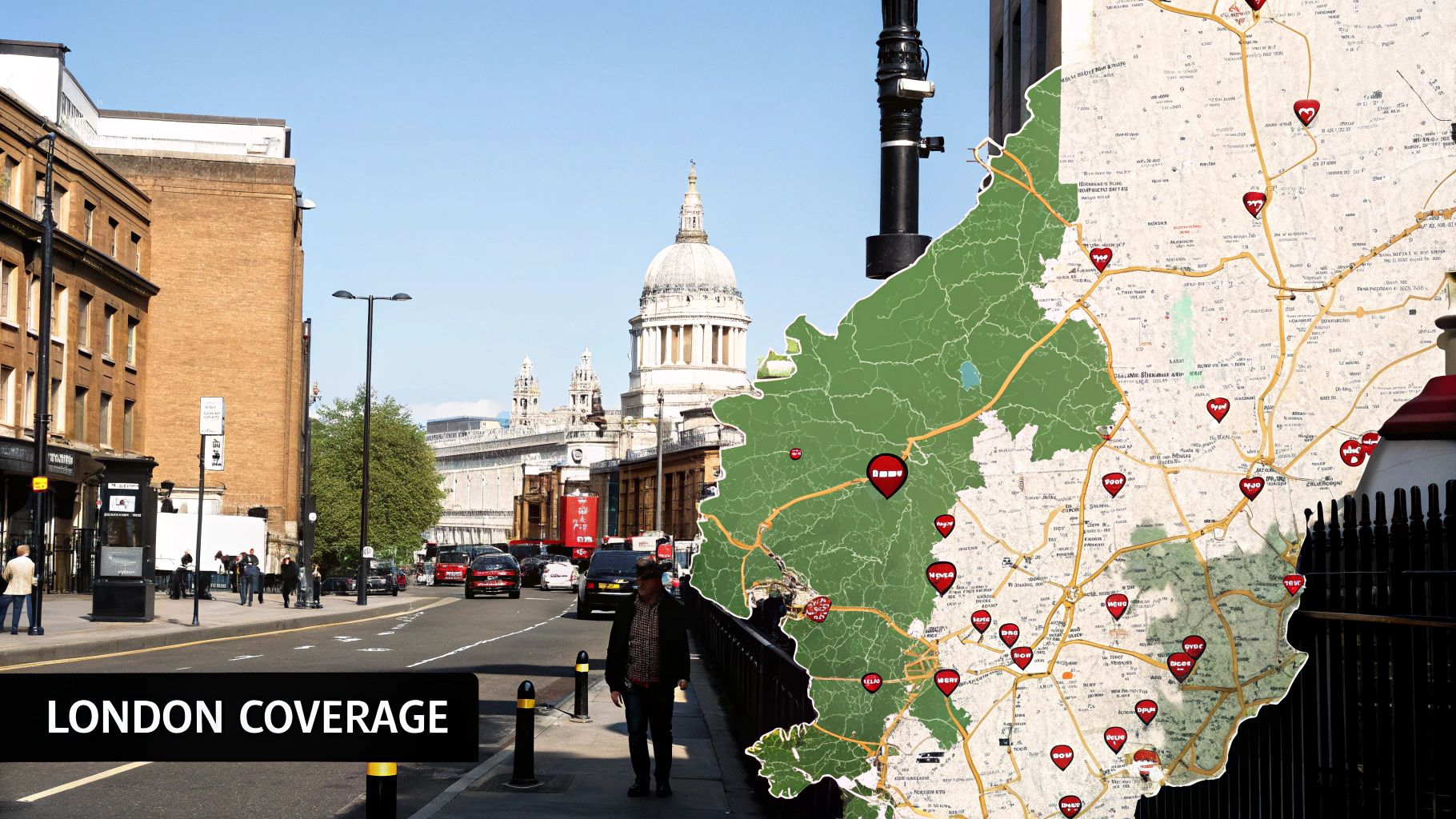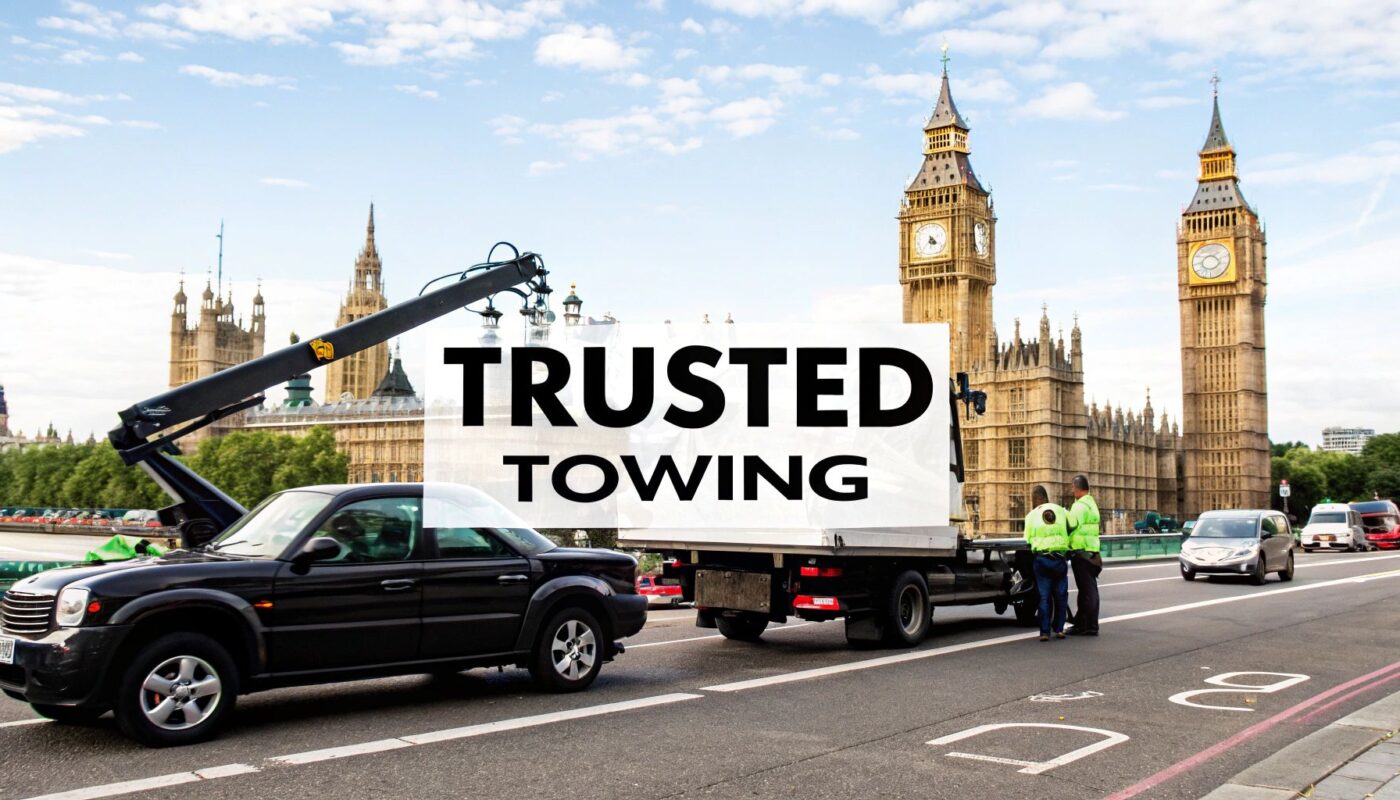Right, so your car’s just given up the ghost in the middle of London, perhaps on the A40 near Hanger Lane or stuck in traffic on the South Circular. That sinking feeling is all too familiar. But before you even think about finding a London towing service, your absolute first priority is safety. It’s not about the car; it’s about you and everyone else on the road.
Your first job is to get that vehicle out of harm’s way. If you’re on a major route like the M25, that means the hard shoulder. If you’re stuck on a busy A-road like the A40, look for the nearest, quietest side street you can limp into.
What To Do When Your Car Breaks Down In London

It’s easy to feel a surge of panic when your car splutters to a stop, but keeping a clear head makes all the difference. The most crucial thing you can do in these first few moments is make sure other drivers can see you, especially on London’s notoriously congested streets.
Once you’re safely out of the main flow of traffic, it’s time to make your car as visible as possible. This is non-negotiable, particularly at night or in the kind of miserable weather we often get in the UK.
Securing Your Vehicle and Yourself
Getting yourself and your vehicle secured is paramount. Don’t even open that phone to search for a tow until you’ve run through these steps.
- Hazard Lights On, Instantly. This is the universal sign for “I’m in trouble.” Flick them on straight away, day or night, to give other drivers a heads-up.
- Get the Warning Triangle Out. If you can do it safely, place a warning triangle about 45 metres (or 147 feet) behind your car on the same side of the road. On a busy London road, only attempt this if you can stay well clear of moving traffic.
- Pop on a High-Vis Vest. You should always have one of these in your car. Putting it on makes you instantly more visible, especially if you have to stand outside the vehicle.
A quick but vital tip: always get out of your car on the side away from traffic. In the UK, that’s usually the passenger side. If you’re on a motorway, get yourself behind the safety barrier and wait there.
With the scene secure, now you can think about getting help. The towing service will need some key details to send the right truck, so get your info ready. Use your phone’s map to find your exact location—a postcode or a clear landmark works best. You’ll also need your car’s make, model, and registration number handy.
Choosing Your London Towing Service Provider
When you’re stuck on the side of a busy London road, the last thing you want is a complicated decision. But who should you call? Do you stick with a traditional membership club you’ve paid for all year, or is a modern, on-demand app a better bet? The right choice can be the difference between a quick rescue and a long, frustrating wait.
For years, UK drivers across England, from Newcastle to London, have relied on the big names: The AA, RAC, and Green Flag. These services work on a subscription model — you pay an annual fee for peace of mind. The main draw is knowing the cost is covered upfront, so there are no nasty surprises when you break down.
The catch? Their major pro is the security of a pre-paid plan. However, a significant con, especially in a city as massive and congested as London, is that their networks can get stretched thin during peak hours. This can sometimes mean you’re left waiting longer than you’d like.
On-Demand Apps Versus Traditional Clubs
The modern alternative is a pay-as-you-go service, usually through a slick app like Crisfix. Instead of being locked into a yearly fee, you only pay for the service when you actually need it. This is a game-changer for drivers who rarely have car trouble or simply don’t want another annual subscription.
The biggest advantage here is often speed. A pro of on-demand apps is their use of GPS to find and dispatch the closest available driver to your exact location, which can dramatically cut down your waiting time on London’s bustling streets. A potential con is that prices can fluctuate based on demand, although you’ll always see the final cost before you book. If you want to dive deeper, check out our full guide to our London towing service.
This image shows what really matters for towing services operating in a fast-paced city like London.

As you can see, even with a high volume of calls, keeping response times low is the key to happy customers.
To make the choice clearer, here’s a quick breakdown of how these services stack up against each other.
Comparing London Towing Service Options
| Feature | Traditional Providers (The AA, RAC, Green Flag) | On-Demand Apps (Crisfix) |
|---|---|---|
| Payment Model | Annual membership fee, paid in advance | Pay-per-use, only when you need it |
| Booking Method | Phone call to a central dispatch centre | Instant booking via a mobile app |
| Typical Wait Times | Can be longer during peak demand in cities like London or Manchester | Often shorter due to localised dispatch in England |
| Cost Transparency | Included in membership, but with potential limits | Upfront price estimate before booking |
| Best For | Drivers wanting a pre-paid “set and forget” plan | Drivers seeking speed, flexibility, and on-the-spot service |
Essentially, the best option depends on what you value most in a stressful situation.
A Quick Look at the Big Players
The UK’s roadside assistance market is a serious business. It’s an industry with revenues of around £1.8 billion, with giants like AA Ltd and RAC Motoring Services holding a huge piece of the pie. Along with Green Flag Ltd, they serve millions of drivers across the nation, from Birmingham to Liverpool.
Your choice really boils down to your personal priorities. If you feel more secure with a pre-paid plan and don’t mind the possibility of a longer wait, a traditional club is a dependable option. But if you prioritise speed, flexibility, and only paying for what you use, an on-demand app like the Crisfix app is almost certainly the better fit for an urgent breakdown in London.
How To Book a Tow Truck with The Crisfix App

When you’re stuck on the roadside, the last thing you want is a complicated process. This is where a dedicated app really shines. Forget being stuck on hold or endlessly Googling for a local service—using an app puts the power right back in your hands.
The whole experience is designed to be fast and intuitive from the moment you download it. You can set up your profile in just a few minutes, which is a real time-saver when you’re in a stressful situation and just need help.
Pinpointing Your Location and Problem
Let’s be honest, trying to describe your exact location in a city like London can be a nightmare. Are you on a packed street in Brixton or a quiet lane in Islington? The Crisfix app takes all the guesswork out of it by using your phone’s GPS to pin your exact location on a map. Simple.
Once your location is locked in, you just need to tell the app what’s wrong. This bit is crucial because it ensures the right kind of truck and equipment gets sent out to you.
- Flat Battery? Just select the jump-start or battery replacement option.
- Post-Accident? Make sure you specify that you need accident recovery, as this almost always requires a flatbed truck.
- Mechanical Failure? Do your best to describe the issue. Something like “engine overheating” or “stuck in gear” gives the driver a clear idea of what to expect.
Giving these details upfront means the right professional arrives ready to work, which avoids any frustrating delays.
Getting a Quote and Tracking Your Truck
Nobody likes a surprise bill. One of the most reassuring features of the app is getting a clear, upfront cost estimate before you confirm anything. You know exactly what you’re paying from the start.
After you confirm, you can actually watch your assigned tow truck moving towards you in real-time on the map. It feels just like tracking a food delivery or a rideshare like Uber or Bolt. You get a proper ETA, so you’re not left on the kerb wondering if anyone is actually coming.
This transparent, on-demand approach is completely changing roadside assistance for the better. It gives you the confidence that a reliable London towing service is truly on its way. To see how this model stacks up against other modern platforms, check out our guide on creating a towing app like Uber.
What Happens When Your Recovery Vehicle Arrives
Seeing the flashing lights of a recovery vehicle is a massive relief. But what happens next? Knowing what to expect when the driver pulls up can make a stressful situation feel a lot more manageable.
A professional driver won’t just hook up your car and drive off. First, they’ll run through a quick but crucial assessment to make sure everything is handled safely and without causing any damage to your vehicle.
They’ll start by confirming the details you provided in the app – checking your destination, whether it’s a local garage in London or a longer trip up to Manchester or Liverpool. They’ll also give your vehicle a once-over to figure out the safest way to secure it for the tow.
Final Checks and Handover
Before your car is loaded onto the truck, this is your chance to have a quick word with the driver. A good service will be transparent and happy to answer any questions you have.
- Ask Smart Questions: Don’t be shy. Ask about their safety procedures for securing a car like yours or for an updated ETA at the destination.
- Remove Personal Items: Do a quick sweep of your car. Grab your phone, wallet, house keys, and any important papers from the glove box.
- Have Documents Ready: It’s a good idea to have your driving licence and vehicle registration (V5C) handy. The driver or the garage might need to see them.
Remember, a professional driver gets it—you’re having a bad day. Their job is to get you and your vehicle to safety as efficiently as possible. A smooth handover helps them get on with the job faster, which is something we cover in our guide on how to call a tow truck without waiting for hours.
This focus on efficiency isn’t just about customer service; it’s vital for keeping our roads moving. Consider this: data on heavy goods vehicles (HGVs) in Great Britain shows that around 30% of HGV kilometres are driven empty. That statistic, available from the RAC Foundation, shows just how critical logistics are.
Having a reliable London towing service ready to clear breakdowns quickly on major routes like the M1 isn’t just a convenience—it’s essential for maintaining traffic flow for everyone.
Getting to Grips with Towing Costs and Settling Up

Let’s be honest, no one wants to deal with surprise fees, especially after the stress of a breakdown. Getting a handle on what actually goes into the cost of a London towing service is the best way to avoid a nasty shock when the bill arrives. The final price isn’t just a number plucked from thin air; it’s a careful calculation based on a few important things.
The biggest factors are pretty straightforward: the type of vehicle you have, how far it needs to go, and even what time of day it is. A standard saloon car needing a quick local tow during the day will always be more affordable than recovering a heavy 4×4 from a tight spot late on a Friday night.
Breaking Down the Bill
The gear needed for the job also makes a big difference to the final price. A simple lift tow might do the trick in some cases, but if you have an automatic, an all-wheel-drive, or a car that’s been damaged in a collision, you’ll almost certainly need a flatbed truck. Because it’s a more specialised vehicle, flatbed services naturally cost a bit more.
The best way to avoid any financial anxiety is to use a service that gives you a quote upfront. This is where apps like the Crisfix app really shine—they calculate the cost based on your specific details and show you a final price to approve before a driver is even sent your way. It completely removes the guesswork.
The UK towing market is a busy one, with around 3,055 towing service providers in operation. A huge chunk of these—about 2,744—are based in England, with cities like London, Manchester, and Birmingham having the highest demand thanks to all the traffic. If you’re curious about the numbers, you can dive into the details with this research on UK towing services.
Finalising the Payment and Finishing the Job
Once your car is safely delivered to its destination—whether that’s your driveway, a local garage, or another spot you’ve picked—it’s time to sort out the payment. Most modern services and on-demand apps make this super easy with secure, cashless payments right through the platform.
It means no fumbling for cash or trying to get a card machine to work on the side of a busy road. After you’ve paid, you should get a digital receipt or invoice sent to you. This is really handy, especially if you need to claim the expense back from your insurance company.
Common Questions About London Towing Services
When your car gives up in the middle of London, a dozen questions can race through your mind. Knowing the answers beforehand can turn a full-blown crisis into just a minor hiccup. Let’s tackle some of the most common worries drivers have when they need a reliable london towing service.
How Long Will I Wait For a Tow Truck in London?
This is the big one, isn’t it? The honest answer is: it depends. In London, your wait time is at the mercy of traffic, the time of day, and where you’ve broken down. Calling a traditional service like The AA or RAC during rush hour in Central London could mean a 60-to-90-minute wait.
This is where modern platforms like the Crisfix app change the game. By using a network of local drivers across the UK, the app can often find someone much closer to you. This simple change can slash wait times to under 45 minutes, especially if you’re in a less congested area.
Can I Get Towed From London To Another City?
Absolutely. This is a pretty standard request. Whether you need to get your car from London to Birmingham, Manchester, or Liverpool, most professional towing companies offer long-distance services.
The cost is usually worked out with a base fee plus a per-mile rate. The key here is to get a firm, all-in quote before the truck sets off. That way, you avoid any nasty surprises when you reach your destination.
Always be crystal clear about where you’re going. Whether it’s a quick trip to a garage around the corner or a long haul across the country, honesty ensures you get the right truck and an accurate price from the start.
What If I Break Down In An Underground Car Park?
Breaking down in a tight, low-ceiling car park is a real headache. It’s a specialist job that not every tow truck can handle. When you book, you must mention any height restrictions.
The dispatcher needs to send a low-clearance recovery vehicle specifically designed for these tight spots. Be prepared for this to cost a bit more, as it requires special equipment. It’s crucial to confirm the provider can actually handle the job before you commit.
Does Car Insurance Cover Towing Costs in the UK?
This really comes down to the fine print of your policy. Many comprehensive insurance plans include breakdown cover as an optional add-on, which usually covers towing. However, if you have a more basic, third-party policy, it’s unlikely to be included as standard.
Your best bet is to dig out your insurance documents or give your provider a quick call to check what you’re covered for. If you’re not, you’ll be paying out-of-pocket, which makes getting a transparent, upfront price even more important.
For a faster, more transparent way to handle any roadside emergency, download the Crisfix App. Get real-time tracking, upfront pricing, and access to a network of professional local drivers, all from your phone. Find out more at https://crisfix.com.





